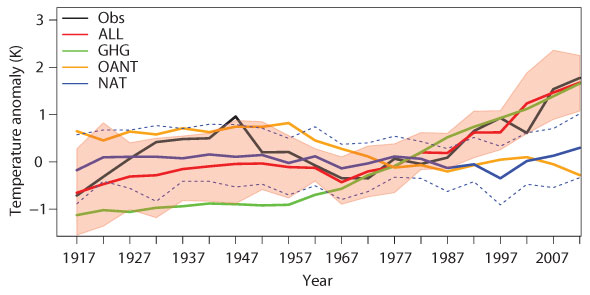You are here
PCIC Researchers Co-Authors on Nature Climate Change Paper Attributing Arctic Climate Change
Recent research published in Nature Climate Change by PCIC's Mohammad Reza Najafi and Francis Zwiers, and Nathan Gillett from the Canadian Centre for Climate Modelling and Analysis attributes the amount of change in surface air temperature in the arctic due to natural forcing agents, anthropogenic greenhouse gas emissions and other anthropogenic forcings (primarily aerosols). In their work, selected as a Nature Research Highlight, they find that anthropogenic greenhouse gases have been responsible for the observed Arctic warming over the past century. They also find that anthropogenic forcings other than greenhouse gases have offset about 60% of the warming that would have occurred if greenhouse gases had acted on their own. They estimate that without this offsetting effect, the arctic warming of 1.2 °C would have been about 3.0 °C. The study uses recently updated surface air temperature datasets assessed by the IPCC, and climate change simulations from models participating in the fifth phase of the Coupled Model Intercomparison Project (CMIP5). These models project a large, 8.3 °C warming by the end of the century under a business as usual scenario, further highlighting the need for reductions in greenhouse gas emissions.
 |
|
Figure 3: Observed and simulated Arctic temperature anomalies, from Najafi, Zwiers and Gillett, 2015. The black line represents five-year mean observed Arctic temperature anomalies, the coloured lines represent the simulated responses to all forcings (red), greenhouse gases alone (green), other anthropogenic forcings alone (mostly aerosols, orange) and natural forcings (blue). Red shading indicates the 5-95% uncertainty range for all forcings, and blue dashed lines indicate the 5-95% uncertainty range for natural forcings only. |
Following a warming trend early in the 20th century and mid-century cooling, surface air temperatures in the Arctic have shown a strong increase over the last few decades, warming at about twice the global average. This polar amplification is thought to be due largely to changes in sea ice, with some contributions from changes in snow cover, atmospheric and ocean circulation, cloud cover and the presence of soot. Some of the projected impacts of climate change on the Arctic region include: damage to infrastructure from permafrost loss and changes in precipitation patterns, spatial shifts and changes to the productivity of marine organisms due to changes in ocean conditions and sea ice, reduced food security for some Arctic communities and impacts on Arctic and sub-Arctic marine mammals, especially those that depend on sea ice.
In order to better understand the causes of the Arctic's changing climate, the authors used observational data and nine CMIP5 global climate models to tease apart the effects of anthropogenic greenhouse gas emissions, natural forcings and other anthropogenic forcings (aerosols, ozone and land use changes). As can be seen in Figure 2, the observational data (in black) falls within the range of climate model simulations that are run using all forcings (shaded red), but lies outside the range of model simulations run using only natural forcings (dashed blue lines). Najafi and colleagues use statistical methods to quantify the contributions of each forcing on Arctic surface temperatures over the interdecadal scale. They repeat their analysis for each season and then with two other observational data sets. The authors find that the results from each of these analyses are consistent, showing that the effects of changes in greenhouse gases, aerosols and other anthropogenic forcings on the climate of the Arctic region can be detected. As detailed above, they conclude that greenhouse gases are responsible for the observed warming in this region and that their effect is being partly offset the effect of other anthropogenic influences, primarily aerosols.
Read the paper at Nature.com.
Najafi, M.R., F.W. Zwiers and N.P. Gillett, 2015: Attribution of Arctic temperature change to greenhouse-gas and aerosol influences. Nature Climate Change, Advance Online Publication, doi:10.1038/NCLIMATE2524.


 Twitter
Twitter Facebook
Facebook Google
Google LinkedIn
LinkedIn